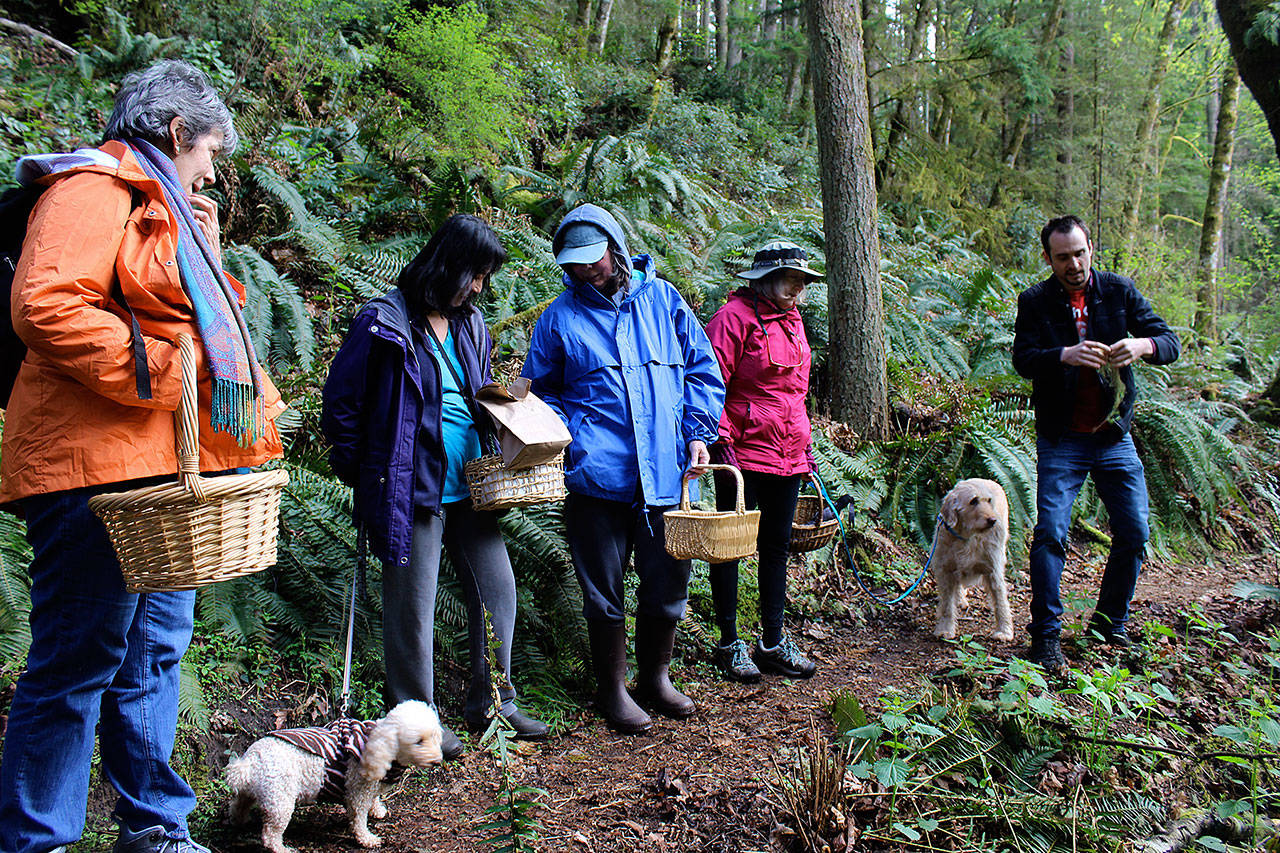Travis Furlanic picks a tiny piece of stinging nettle, pops it into his mouth and reels off its versatile virtues — good for tea, healing and nourishment.
“I love stinging nettle,” he says. “I just take a little bit, ball it up and eat it.”
Such tidbits are learned — and tasted — along the way when Furlanic gives tips about foraging for his favorite fungi of the forest, mushrooms.
“Finding ways to eat in the wild has been a passion of mine for a long time,” says Furlanic, who leads Whidbey Wild Mushroom Tours. “Now I’m fixated and focused on mushrooms and have been a mushroom guy for 12 years.”
For the second year, Furlanic is offering three-hour classes on Saturdays in the spring and fall. They consist of an indoor workshop followed by a stroll through various woods around South Whidbey. Students learn basic hands-on mushroom identification and retain a connection to one of the island’s most passionate mushroom maestros.
Furlanic teaches the characteristics and variations of mushrooms, their role in forest life and mushrooms’ reported health benefits.
How to spot and avoid toxic and potentially deadly mushrooms is reviewed first, followed by common and edible mushrooms for beginners to seek out.
“There’s lots of edible mushrooms out there,” said Furlanic, a Langley resident who graduated from South Whidbey High School in 2004. “Most good gourmet mushrooms you want to go for are easy to recognize.”
The class costs $45 for adults, $35 for seniors and $25 for students, children 12 and under are free.
The class meets at 1 p.m. on Saturdays in the cafe at Langley’s Mukilteo Coffee Roaster Cafe in the Woods, where students can grab lunch or a cup of joe while sitting among stacks of roasted beans.
Participants receive an informational packet filled with mushroom hunting tips, drawings and photos. After their first class, they can also join any of the mushroom hikes in subsequent classes. This spring’s schedule started April 6 and ends May 25.
Furlanic repeatedly stresses the No. 1 rule of mushroom picking: When in doubt, throw it out.
“Mushrooms are guilty until proven innocent,” Furlanic told a recent class of a half dozen residents from around South Whidbey. “There’s about eight or so that will kill you but lots of them will make you sick.”
Furlanic teaches about poisonous mushrooms first “to get it out of the way.”
With every just-picked mushroom specimen someone is eating for the first time, he recommends cooking it well and taking just a tiny taste. Waiting to see if there is a disruptive digestive reaction is especially important for mushrooms identified as “edible with caution.”
Pointing to a photo of a mushroom known as a false morel, Furlanic describes its potential toxicity.
“Eat it, it coverts to rocketship fuel and kills you,” he warns.
Mushrooms are scary, yes, but also so wonderfully delicate and delicious. That’s why most people said they came to the class with their own wicker basket in hand to learn how to discern the flavorful from the fatal.
“I love mushrooms,” declared Sue LeClair. “I did this class last fall and it was so helpful, I’m taking it again to keep learning and feel more confident about finding them.”
On a recent Saturday, Furlanic distributed directions to the Whidbey Institute in Clinton after the Cafe in the Woods workshop. Students drove there and met him for a non-demanding stroll on a few hiking trails, where they peered under rotting stumps and up at trees for lines of mushrooms crawling up trunks.
The first specimen spotted turned out to be one of the most prolific — an oyster mushroom.
“Oysters mushrooms come out in the spring and they’re really common,” Furlanic says as he picks one from a cluster. “You really can’t over pick. When you do pick it, pull the whole mushroom out.”
Up the trail, a student spots a group of mushrooms that look like horizontal pieces of bark jutting out from a fallen tree.
“Turkey tail,” says Furlanic. He holds it up his nose and encourages his students do the same to learn the many aspects of mushroom’s many attributes.
“It’s a very sensory experience, mushroom hunting,” he says. “You want to know what it smells like.”
Some smell like anise, others not so nice.
“Matsutake mushrooms sell for $70 a pound,” Furlanic tells his group, “but they smell like cinnamon wet socks. No one will tell you where they are on the island, including me.”
Barbara Elliott filled her basket to the brim with a variety of mushrooms in many mottled colors and shapes — oyster, turkey tail and chanterelle.
“I saute them very slowly in butter, add some herbs and they are so good,” she says.
Mushrooms go by many names, some based on their shape, size and other factors but memorizing all the names in Latin and English could prove crazy-making.
Some are obvious. A lobster mushroom (hypomyces lactifluorum) is super big and super bright red. Morels (morchella) look like a brain on a stem; one called a shrimp russula (russula xerampelina) smells like a shrimp while the lions mane (hericium) is a creamy white blob of shaggy-looking tentacles.
“Lions mane, also called a bear’s head, can get huge enough to feed four people,” Furlanic says as he reviews his Top Ten Picks for Beginners. “They are delicious.”
• Whidbey Wild Mushroom Tours meet 1 p.m. every Saturday through May 25 at Mukilteo Coffee Roasters Cafe in the Woods, 3228 Lake Leo Way, Langley. Registration recommended. Cost $45 adult, $35 senior, $25 student, children age 12 and under are free. For more information, www.whidbeymushroomtours.com
• Mushrooms collected by Travis Furlanic are occasionally for sale at a few retail locations, including Whidbey Wonders at Ken’s Korner in Clinton.


